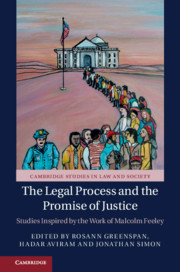Book contents
- The Legal Process and the Promise of Justice
- Cambridge Studies in Law and Society
- The Legal Process and the Promise of Justice
- Copyright page
- Contents
- About the Contributors
- Introduction: Past as Prologue
- Part I The Process Is the Punishment
- Part II Court Reform on Trial
- Part III Judicial Policymaking and the Modern State
- Part IV Political Liberalism and the Legal Complex
- Index
- Books in the Series
- References
Part I - The Process Is the Punishment
Published online by Cambridge University Press: 18 April 2019
- The Legal Process and the Promise of Justice
- Cambridge Studies in Law and Society
- The Legal Process and the Promise of Justice
- Copyright page
- Contents
- About the Contributors
- Introduction: Past as Prologue
- Part I The Process Is the Punishment
- Part II Court Reform on Trial
- Part III Judicial Policymaking and the Modern State
- Part IV Political Liberalism and the Legal Complex
- Index
- Books in the Series
- References
Summary

- Type
- Chapter
- Information
- The Legal Process and the Promise of JusticeStudies Inspired by the Work of Malcolm Feeley, pp. 17 - 94Publisher: Cambridge University PressPrint publication year: 2019
References
References
Cases
Brady v. Maryland, 373 U.S. 83 (1963)
Connick v. Thompson, 563 U.S. 51 (2011)
Miranda v. Arizona, 384 U.S. 436 (1966)
Additional Sources
References
References
References
Cases
Adickes v. S.H. Kress & Co., 398 U.S. 144 (1969).
Anderson v. Liberty Lobby, 477 U.S. 242 (1986).
Ashcroft v. Iqbal, 556 U.S. 662 (2009).
AT&T Mobility v. Concepcion, 563 U.S. 333 (2011)
Bell Atlantic Corp. v. Twombly, 550 U.S. 544 (2007).
Celotex Corp. v. Catrett, 477 U.S. 317 (1986).
Conley v. Gibson, 355 U.S. 41 (1957).
Epic Systems Corp. v. Lewis, 138 S. Ct. 1612 (2018).
Matsushita Electrical Industrial Corp. v. Zenith Radio, 475 U.S. 574 (1986).
Poller v. CBS, Inc., 368 U.S. 464 (1962).
Shearson/American Express, Inc. v. McMahon, 482 U.S. 220, 232 (1987).
Wal-Mart Stores, Inc. v. Dukes, 564 U.S. 338 (2011).
American Express Co. v. Italian Colors Restaurant, 570 U.S. 228 (2013).
Rules
Fed. R. Civ. Pro. Rule 1
Fed. R. Civ. Pro. Rule 8
Fed. R. Civ. Pro. Rule 23
Fed. R. Civ. Pro. Rule 26
Fed R. Civ. Pro. Rule 26(b)(1) 398 U.S. 977, 982 (1970) (amended 2000)
Statutes
Civil Code § 1793.22(c)



